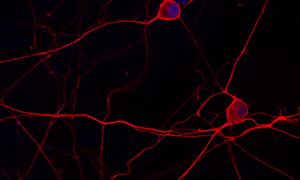
Neurotrophins and mRNA
Does chronic pain alter gene activity and gene-dependent synthesis of proteins in the axon of a pain conducting nerve fibre? In neuropathies, that means painful nerve inflammations, the function of these sensory nerve cells is altered via neurotrophic factors such as Brain Derived Neurotrophic Factor (BDNF) and Nerve Growth Factor (NGF), so that pain can become chronic. Both factors are neurotrophins, stimulating the growth and connectivity of nerve cells. They bind to so-called tyrosine kinase receptors (Trk receptors) on the membrane surface of the nerve cell and thereby exert their effects.
However, their short- or long-term action on the nerve cell may lead to a change in mRNA distribution in nerve cell processes. Consequently, the synthesis of proteins in axons and synaptic compartments – the cell regions that are crucial for stimulus triggering – might be altered, which in turn would influence the excitability and signal transmission to other nerve cells.
Research Goal
Project 8 of ResolvePain will investigate how the actions of neurotrophins affect local protein synthesis leading to altered excitability and pain chronification.
Preclinical studies
Newly developed neuronal cell culture techniques are used to analyse the transcriptomes of the somatic and axonal regions of nociceptive neurons. This is performed using microfluidic chambers, which allow the outgrowth of nerve cell processes into a separate part of the cell culture chamber. The molecules identified from this will be investigated with regard to their function in pain excitation in further experiments in tissue samples from patients and their significance in pain recovery patterns will be analysed.
Clinical study
In parallel, effects of neurotrophins in samples from patients with complex regional pain syndrome or polyneuropathies will be studied, which often occur as side effects of the chemotherapeutic drug bortezomib, and their significance in pain resolution will be determined.
Modern techniques
In cooperation with the University of Leipzig, a high-resolution microscopy technique is used to also visualize structural changes in the cells of the dorsal root ganglia.
In addition, P8 provides technical support to other projects, such as techniques for neuronal cell culture based on human stem cells, or laser-assisted qPCR from tissue sections.
Importance
Knowledge of local protein synthesis mechanisms in pain generation and resolution is still limited. In particular, insights into the molecular and cellular functions of Trk receptors under the influence of neurotrophins in the axon of a pain receptor could open new paths in pain therapy.
Research Team P8
Head
Univ.-Prof. Dr. Michael Sendtner, MD
Institute of Clinical Neurobiology
University Hospital Würzburg
PD Dr. rer. nat. Michael Briese
Institute of Clinical Neurobiology
University Hospital Würzburg,
Members of the team
Maximilian Koch, PhD Student
Manas Kshirsagar, PhD Student
Ankita Rawat, PhD Student
Selected publications
Briese M, Haberman N, Sibley CR, Faraway R, Elser AS, Chakrabarti AM, Wang Z, Konig J, Perera D, Wickramasinghe VO, Venkitaraman AR, Luscombe NM, Saieva L, Pellizzoni L, Smith CWJ, Curk T, and Ule J (2019)
A systems view of spliceosomal assembly and branchpoints with iCLIP
Nat Struct Mol Biol 2019, 26: 930-940
Go to publication
Briese M, Saal-Bauernschubert L, Changhe J, Moradi M, Ghanawi H, Uhl M, Appenzeller S, Backofen R, Sendtner M (2018)
hnRNP R and its main interactor, the noncoding RNA 7SK, coregulate the axonal transcriptome of motoneurons
PNAS 2018; 115 (12): E2859-E2868
Go to publication
Briese M, Saal L, Appenzeller S, Moradi M, Baluapuri A, Sendtner M (2016)
Whole transcriptome profiling reveals the RNA content of motor axons
Nucleic Acids Res 2016, 44: e33.
Go to publication
Hornburg D, Drepper C, Butter F, Meissner F, Sendtner M, Mann M (2014)
Deep proteomic evaluation of primary and cell line motoneuron disease models delineates major differences in neuronal characteristics
Mol Cell Proteomics 2014; 13: 3410-3420.
Go to publication
Lüningschrör P, Binotti B, Dombert B, Heimann P, Perez-Lara A, Slotta C, Thau-Habermann N, Rüth von Collenberg C, Karl F, Damme M, Horowitz A, Maystadt I, Füchtbauer A, Füchtbauer EM, Jablonka S, Blum R, Üçeyler N, Petri S, Kaltschmidt B, Jahn R, Kaltschmidt C, Sendtner M (2017)
Plekhg5-regulated autophagy of synaptic vesicles reveals a pathogenic mechanism in motoneuron disease
Nature Comm. 2017, 8: 678
Go to publication
Moradi M, Sivadasan R, Saal L, Luningschror P, Dombert B, Rathod R.J, Dieterich DC, Blum R, Sendtner M (2017)
Differential roles of alpha-, beta-, and gamma-actin in axon growth and collateral branch formation in motoneuronsJ
Cell Biol 2017; 216: 793-814
Go to publication
Puehringer D, Orel N, Luningschror P, Subramanian N, Herrmann T, Chao MV, Sendtner M (2013)
EGF transactivation of Trk receptors regulates the migration of newborn cortical neurons
Nat Neurosci 2013; 16: 407-415
Go to publication
Simon CM, Rauskolb S, Gunnersen JM, Holtmann B, Drepper C, Dombert B, Braga M, Wiese S, Jablonka S, Puhringer D, Zielasek J, Hoeflich A, Silani V, Wolf E, Kneitz S, Sommer C, Toyka KV, and Sendtner M (2015)
Dysregulated IGFBP5 expression causes axon degeneration and motoneuron loss in diabetic neuropathy
Acta Neuropathol 2015; 130: 373-387
Go to publication
Sivadasan R, Hornburg D, Drepper C, Frank N, Jablonka S, Hansel A, Lojewski X, Sterneckert J, Hermann A, Shaw PJ, Ince PG, Mann M, Meissner F, Sendtner M (2016)
C9ORF72 interaction with cofilin modulates actin dynamics in motor neurons
Nat Neurosci 2016; 19: 1610-1618.
Go to publication
Yadav P, Selvaraj BT, Bender FL, Behringer M, Moradi M, Sivadasan R, Dombert B, Blum R, Asan E, Sauer M, Julien JP, Sendtner M (2016)
Neurofilament depletion improves microtubule dynamics via modulation of Stat3/stathmin signaling
Acta Neuropathol 2016; 132: 93-110
Go to publication



